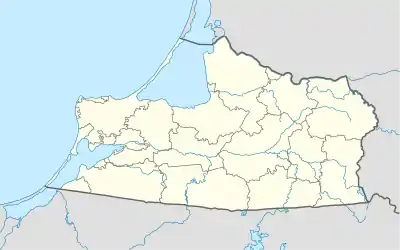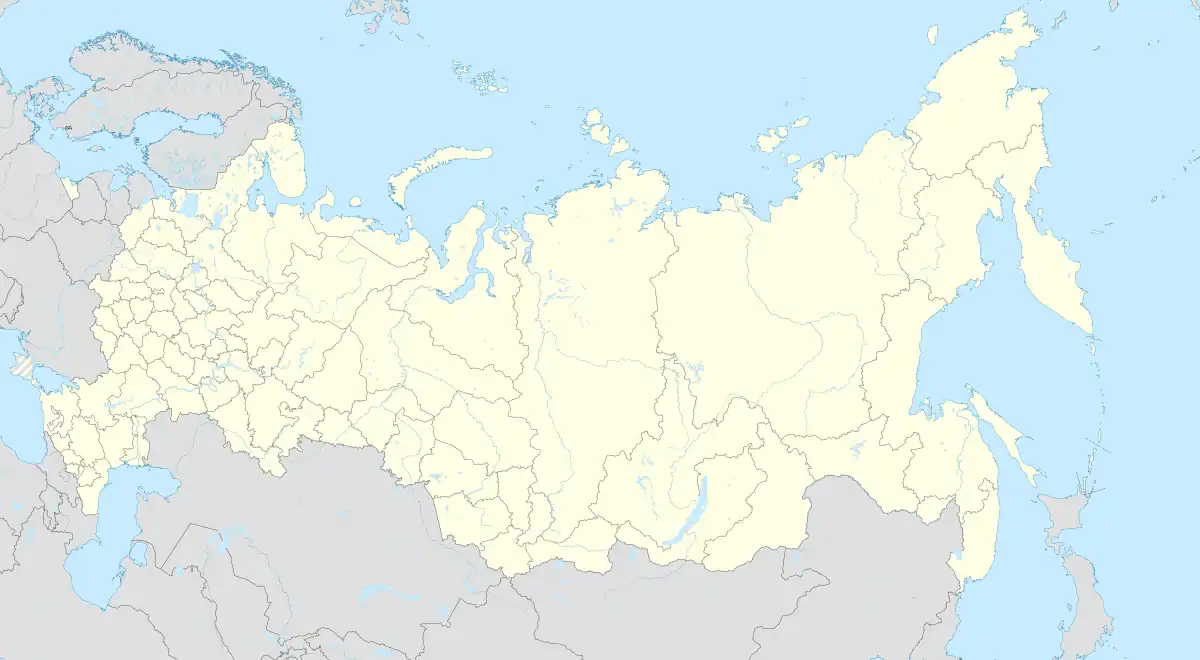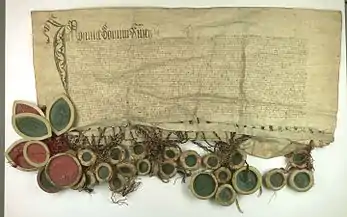Krylovo, Kaliningrad Oblast
Krylovo[lower-alpha 1] is a rural locality (a settlement) in Pravdinsk Urban Okrug, Pravdinsky District, Kaliningrad Oblast, Russia. Population: 785 (2010 Census);[1] 756 (2002 Census);[2]
Krylovo
Крылово | |
|---|---|
Settlement | |
 Krylovo .svg.png.webp) Krylovo  Krylovo | |
| Coordinates: 54°20′50″N 21°33′20″E | |
| Country | Russia |
| Region | Kaliningrad Oblast |
| District | Pravdinsky District |
| Municipality | Pravdinsk Urban Okrug |
| Time zone | UTC+3:00 |
History

The first written mention of what is now Krylovo was placed in the Chronica nova Prutenica ("New Prussian Chronicle") by Wigand of Marburg (completed around 1394) in connection with the raid of pagan Lithuanians, which took place in 1366. In the 15th-century. here, in the historic region of Bartia, a small castle of the Teutonic Order was built; later the colonists were settled here.
The foundation of the town of Nordenburg is usually regarded as 1405. On 24 July 1407, the community received Kulm law privileges from the Grand Master of the Teutonic Order Ulrich von Jungingen.[3] In 1454, the town was incorporated to the Kingdom of Poland by King Casimir IV Jagiellon upon the request of the anti-Teutonic Prussian Confederation.[4] Following the peace treaty of 1466, it was a part of Poland as a fief held by the Teutonic Knights.[5] From the 18th century, it was part of the Kingdom of Prussia, and from 1871 also Germany. In the 18th century, there were Polish, Lithuanian and German preachers in the town, however, as a result of Germanisation policies, in the late 19th century church services were held only in German.[6] In 1880, the town had a population of 2,515, mostly employed in agriculture. [6] The town was occupied by Russia during the Seven Years' War in 1757 and during World War I in 1914.[7]
After Germany's defeat in the Second World War, Nordenbork, as it was historically called in Polish, initially passed to Poland, within which it was located in the Gierdawy County. It became its county seat after the unilateral annexation of the former county seat of Gierdawy by the Soviet Union. After another unilateral redrawing of the border by the Soviets, Nordenbork was also annexed from Poland, so the seat of the Gierdawy County was moved to Skandawa, and eventually the county was disbanded. Nordenbork became part of the Gerdauensky District. On 5 July 1950, Nordenburg was renamed Krylovo. Since December 1962, the village has become part of the Pravdinsky District.[7]
Administrative and municipal status
Within the framework of municipal divisions, since 5 May 2015, the territories of the town of district significance of Pravdinsk, including Krylovo, the urban-type settlement of district significance of Zheleznodorozhny, and of two rural okrugs of Pravdinsky District are incorporated as Pravdinsky Urban Okrug.[8] Before that, the town of district significance was incorporated within Pravdinsky Municipal District as Pravdinskoye Urban Settlement.[8]
Transport
Regional road 27A-028 (ex A 196) coming from Kaliningrad and regional road 27A-042 (ex A 197) coming from Bolshakovo via Chernyakhovsk meet in Krylovo and end at the border with Poland.
Before 1945, Nordenburg was a railway station on the Königsberg (Kaliningrad)–Löwenhagen (Komsomolsk)–Gerdauen (Zheleznodorozhny)–Angerburg (Węgorzewo) railway. In addition, two small railway lines ended in Nordenburg: the line (Insterburg (Chernyakhovsk)–) Warnaschel–Nordenburg of the Insterburg small railways and the line (Rastenburg (Kętrzyn)–) Barten (Barciany)–Nordenburg of the Rastenburg small railways. Rail transport no longer exists in Krylovo.
The water tower at the train station was renovated in 2020.[9]
Notes
- Russian: Крылово, German: Nordenburg, Lithuanian: Ašvėnai, Polish: Nordembork (Oświn)
References
- Russian Federal State Statistics Service (2011). Всероссийская перепись населения 2010 года. Том 1 [2010 All-Russian Population Census, vol. 1]. Всероссийская перепись населения 2010 года [2010 All-Russia Population Census] (in Russian). Federal State Statistics Service.
- Russian Federal State Statistics Service (21 May 2004). Численность населения России, субъектов Российской Федерации в составе федеральных округов, районов, городских поселений, сельских населённых пунктов – районных центров и сельских населённых пунктов с населением 3 тысячи и более человек [Population of Russia, Its Federal Districts, Federal Subjects, Districts, Urban Localities, Rural Localities—Administrative Centers, and Rural Localities with Population of Over 3,000] (XLS). Всероссийская перепись населения 2002 года [All-Russia Population Census of 2002] (in Russian).
- Эта привилегия была впервые опубликована по копиям из Тайного государственного архива прусского культурного наследия в Берлине (с русским переводом и подробным комментарием) в книге: Рогачевский А.Л. Очерки по истории права Пруссии XIII–XVII вв. (По материалам рукописных собраний Берлина и Санкт-Петербурга). СПб., 2004. С. 187–243.
- Górski, Karol (1949). Związek Pruski i poddanie się Prus Polsce: zbiór tekstów źródłowych (in Polish). Poznań: Instytut Zachodni. p. 54.
- Górski, pp. 96–97, 214–215
- Słownik geograficzny Królestwa Polskiego i innych krajów słowiańskich, Tom VII (in Polish). Warszawa. 1886. p. 176.
{{cite book}}: CS1 maint: location missing publisher (link) - "Кrylovo". Archived from the original on 2016-04-13. Retrieved 2013-01-02.
- Law #418
- Walter Mogk (2020). Wasserturm gerettet. p. 22.
{{cite book}}:|work=ignored (help)